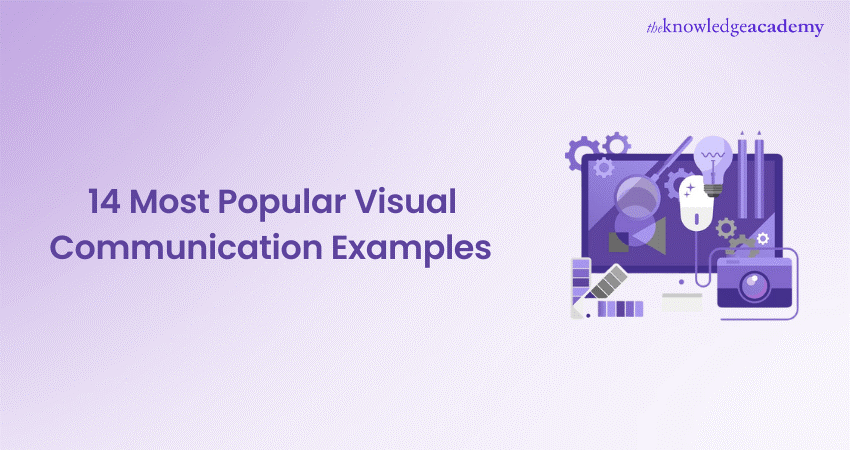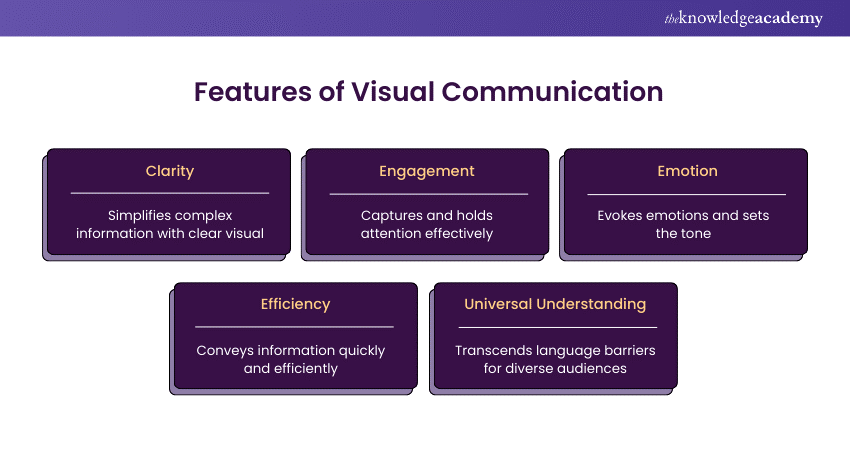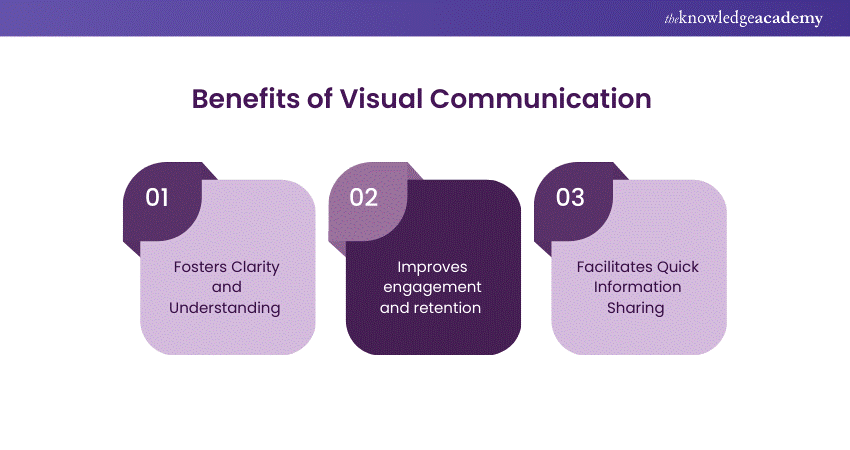We may not have the course you’re looking for. If you enquire or give us a call on 01344203999 and speak to our training experts, we may still be able to help with your training requirements.
Training Outcomes Within Your Budget!
We ensure quality, budget-alignment, and timely delivery by our expert instructors.

Feeling overwhelmed by text-heavy presentations and struggling to grab your audience's attention? You're not alone! Traditional communication methods can sometimes miss the mark. The power lies in Visual Communication that can instantly engage and inform your viewers. But where do you begin? With countless options available, choosing the right Visual Communication type can feel overwhelming. Fear not, fellow communicators! This blog on Visual Communication Examples will be your treasure trove of inspiration.
We'll delve into 14 of the most popular and effective Visual Communication examples, from the timeless power of infographics to the engaging world of animation. By the end, you'll be armed with a diverse toolkit of Visual Communication methods, ready to transform your presentations and captivate your audience!
Table of Contents
1) What Is Visual Communication?
2) Benefits of Visual Communication
a) Fosters Clarity and Understanding
b) Improves engagement and retention
c) Facilitates Quick Information Sharing
3) Examples of Visual Communication
4) Conclusion
What is Visual Communication?
Visual Communication employs imagery to share ideas and data. This encompasses a range of visuals, from graphs and charts to photos, videos, and even gestures. Its essence lies in visual dependency, which serves as an efficient medium for swift and direct message conveyance, bypassing textual explanations.

Visuals are instrumental in distilling intricate details, captivating attention, and complementing spoken words. For example, an expertly crafted infographic can render complex statistics digestible and memorable, while a straightforward flowchart can depict a procedure or system more succinctly than text.
Given our innate attraction to visual stimuli and our ability to interpret them quicker than text, visual elements become indispensable in fields like marketing, education, and corporate communications, where the rapid and unambiguous transmission of messages is key.
Benefits of Visual Communication
Here are the benefits of Visual Communication:

1) Fosters Clarity and Understanding
Utilising visuals like images, videos, and graphs can significantly clarify and enhance understanding of concepts.
Take a screenshot, for instance: it can capture a screen’s exact state, offering a visual reference that’s often more informative than text alone. This helps eliminate confusion, aligns understanding among all parties, and leads to more efficient task completion with reduced errors.
2) Improves engagement and retention
When running a business, enhancing customer engagement is crucial for retention. Visual Communication is key in elucidating complex ideas in an engaging manner.
The average attention span is dwindling, now hovering around 47 seconds for content engagement! Capitalising on this brief window means employing eye-catching visuals.
From dynamic video presentations to interactive dashboards and well-crafted infographics, visuals enrich the learning process and information retention—vital in training materials where grasping new concepts is essential.
Visuals invoke mental images and emotions, anchoring the learning experience in memory. They also accommodate various learning preferences, broadening the reach of your message.
3) Facilitates Quick Information Sharing
Visuals enable the swift creation and sharing of easily digestible data. They simplify the process of generating, disseminating, and gathering feedback.
Creating a visual—be it a sketch, annotated screenshot, or graph—is typically quicker and more instinctive than writing extensive descriptions. A visual like a chart or infographic can be shared instantly, saving time otherwise spent on detailed textual explanations.
Moreover, visuals facilitate immediate feedback. Recipients can annotate directly on the visual medium, making their feedback straightforward and actionable.
Examples of Visual Communication
The following are the examples of Visual Communication
1) GIFs
GIFs serve as a delightful element in presentations, effectively capturing the audience's attention or rekindling their interest. They offer a playful touch to content that might otherwise be dull and provide illustrative guidance in products or procedures, among various other applications.
2) Whiteboard Animation
Whiteboard animation is favoured for instructional or explanatory content, often showcasing a visual representation that accompanies an off-screen narrator’s voiceover. It’s an excellent format for explainer videos that articulate the details of a product, the steps of a process, or a particular perspective.
3) Screen Recording
When educating on technology, a screen recording can be an invaluable teaching tool. It provides viewers with a direct visual guide, demonstrating precisely the actions they need to perform. This method is particularly effective for guiding users through a new or unfamiliar digital environment, such as a software platform or User Interface (UI).
By capturing the exact process on screen, viewers can follow along in real-time, making it easier to understand and replicate the steps on their own. This hands-on visual approach simplifies the learning curve, especially for complex tasks, and can significantly enhance the user’s ability to navigate and utilise new tech tools efficiently.
4) Data Visualisation
Data visualisation elevates the concept of infographics by transforming extensive and complex data sets into comprehensible visual formats. This method makes it easier to discern patterns, fluctuations, and correlations among variables. By presenting data visually, it allows viewers to step back and observe these connections unfold, providing a clearer understanding of the underlying dynamics at play.
In essence, data visualisation acts as a lens, magnifying the intricate dance of data points and translating them into a visual language that can be quickly grasped. It's a powerful technique for making sense of vast quantities of information, enabling viewers to perceive subtle nuances and overarching trends that might otherwise go unnoticed in raw numerical form. Through charts, graphs, and interactive displays, data visualisation helps to illuminate the stories hidden within the numbers, offering a more intuitive and engaging way to interact with information.
5) Stock Footage or Recorded Video
When the term “video” is mentioned, it often conjures up the traditional format of moving visuals with sound—a medium that, despite the evolution and diversification of its applications, continues to hold its ground effectively.
Originally, videos were primarily a form of entertainment or news broadcasting. However, their use has broadened to encompass educational content, marketing, social media, and more. Despite this expansion, the classic approach to video production—storytelling through a sequence of visuals accompanied by audio—remains a potent method for communication and engagement.
The enduring appeal of traditional videos lies in their ability to weave narratives that resonate with viewers, whether it’s through a captivating film, an informative news segment, or a compelling advertisement. The fundamental principles of good video creation, such as clear storytelling, quality production, and emotional connection, are timeless and continue to be the cornerstone of effective Visual Communication.
6) Face-to-camera video
Talking head videos, commonly used by content creators like vloggers, critics, corporate leaders, and educators, consist of straightforward recordings of an individual speaking directly to the camera. Although some may find this direct approach daunting, presenting oneself on camera can significantly foster trust, personalise your brand, and associate a face with your identity.
When combined, Visual Communication techniques can have an even stronger effect. Integrating a screen recording with a face-to-camera segment reinforces the personal touch in a tutorial video. Sequentially revealing information through an animated infographic can enhance its impact. Similarly, incorporating relevant graphs into a whiteboard animation can effectively underscore your message.
7) Films and documentaries
Mediums like short films and documentaries are recognised as a potent form of Visual Communication. The combination of imagery with audio and storytelling enables the conveyance of messages that are both comprehensive and highly resonant in contemporary culture.
By integrating visual elements with sound and narrative, these cinematic forms can communicate complex ideas and emotions, making them a widely embraced and influential method of expression in today’s society. They not only entertain but also inform and provoke thought, often leaving a lasting impact on their audience.
8) Presentations
Presentations serve as an effective tool for disseminating key information and updates to employees, potential clients, and even friends (the trend of 'presentation parties' gained traction during the pandemic). In a professional setting, you may need to conduct a meeting to review the past quarter's performance and establish goals for the next one.
Employing a presentation with visual aids can significantly enhance the impact compared to merely verbalising the data. Strong visual elements like images, charts, and highlights help ensure that the audience grasps and retains the information better. Moreover, visuals add an element of engagement to presentations, making them more compelling without necessarily requiring a lot of additional preparation time.
9) Checklists
Checklists are unparalleled when it comes to boosting efficiency. They are invaluable tools for organising both professional tasks and personal affairs. The variety of checklists is vast, ranging from grocery lists for a teenager embarking on their university journey, to pre-travel checklists ensuring all essential tasks are completed before a significant trip, or project to-do lists outlining critical steps. Utilised in personality development training, checklists are strategic tools designed to minimise errors, acknowledging the limitations of relying solely on human memory.
10) Mind maps/content maps
Whenever you're uncertain, create a mind map! It's the most effective way to visually organise complex and non-linear information. Mind maps employ radial thinking, where various lines and connections illustrate the relationships between a central idea and its related concepts.
11) Graphs and charts
Graphs are best utilised to simplify complex data and make it more accessible. Graphs are commonly utilised to present quantitative or definitive data, such as illustrating a company's growth or benchmarking figures against a rival. The art of data visualisation is unique, as it involves not only handling data but also selecting the appropriate graph type and scale to best represent the information, which is not always straightforward. There's a plethora of graph options available, including line graphs, bar charts, and pie charts. To convey a broad spectrum of data, you can even amalgamate various graphs into a single, comprehensive infographic.
12) Images
It's often said that a picture is worth a thousand words, and this adage holds true, especially when trying to convey your perspective. Incorporating a visual element can significantly enhance the communication of your ideas, making them more impactful and easier to grasp. If you have the opportunity to use an image to illustrate your point, it's definitely worth doing so. Visuals can bridge the gap between abstract concepts and concrete understanding, providing a powerful tool for expression that transcends the limitations of language.
13) Infographics
Infographics are a powerful tool for presenting complex data and statistics in a format that's easy to understand and visually engaging. They transform intricate information into a compelling visual narrative, making it more approachable for the audience. The use of charts and graphs within infographics allows viewers to quickly comprehend and analyse data, offering clarity that might be lost in textual explanations. This visual format not only simplifies the absorption of information but also enhances its impact, facilitating a more effective and memorable communication experience.
14) Animation
Animated content, whether it be videos, images, or text, captivates an audience far more effectively than static images or plain text. The power of animation lies in its capacity to simplify complex ideas, making them accessible and engaging to a diverse audience. This dynamic medium can breathe life into abstract concepts, ensuring they resonate with viewers from all walks of life.
Conclusion
Capturing your audience's attention with text-heavy presentations is challenging. Visual Communication offers a solution by instantly engaging and informing viewers. These visual communication examples we've explored, like infographics and animations, provide tools to enhance your presentations. Implement these visual strategies to foster understanding, improve engagement, and facilitate quicker information sharing.
Frequently Asked Questions

Visuals are web design's language, guiding users, conveying information, and creating a strong first impression. Effective use of images, colours, and layouts enhances usability and brand identity.

Visual communication directly impacts UX. Clear visuals guide users, structure content, and establish hierarchy. Poor visual communication creates confusion and frustration, hindering user experience (UX).

The Knowledge Academy takes global learning to new heights, offering over 30,000 online courses across 490+ locations in 220 countries. This expansive reach ensures accessibility and convenience for learners worldwide.
Alongside our diverse Online Course Catalogue, encompassing 17 major categories, we go the extra mile by providing a plethora of free educational Online Resources like News updates, Blogs, videos, webinars, and interview questions. Tailoring learning experiences further, professionals can maximise value with customisable Course Bundles of TKA.

The Knowledge Academy’s Knowledge Pass, a prepaid voucher, adds another layer of flexibility, allowing course bookings over a 12-month period. Join us on a journey where education knows no bounds.

The Knowledge Academy offers various Communication Skills Courses, including Assertiveness Skills Training, Business Communication Training and Visual Communication Training. These courses cater to different skill levels, providing comprehensive insights into Communication Barriers.
Our Business Skills Blogs cover a range of topics related to Visual Communication, offering valuable resources, best practices, and industry insights. Whether you are a beginner or looking to advance your Visual Communication skills, The Knowledge Academy's diverse courses and informative blogs have got you covered.
Upcoming Business Skills Resources Batches & Dates
Date
 Visual Communication Course
Visual Communication Course
Fri 7th Feb 2025
Fri 4th Apr 2025
Fri 6th Jun 2025
Fri 8th Aug 2025
Fri 3rd Oct 2025
Fri 5th Dec 2025







 Top Rated Course
Top Rated Course



 If you wish to make any changes to your course, please
If you wish to make any changes to your course, please


